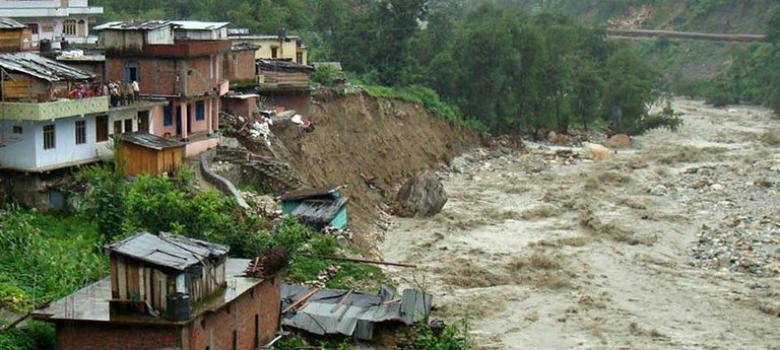
Photo : Scroll.in
We all have heard about flood. It is like an annual event in a country, a state or in an area. Flood is a natural calamity like earthquakes, cyclones and tsunamis. It has been occurring since the time immemorial. Many great civilizations were washed away by great floods.
A flood is nothing but a mass of water which overflows from water bodies such as rivers, lakes or oceans in which the water overtops or breaks the levees and spreads on the land causing flood. Sometimes when there is heavy rainfall in the hills huge currents of water come down from the hills to the rivers and when rivers and seas can’t control this water they cause an overflow on the banks which we call floods.
Floods can also occur in the rivers when the flow rate in the rivers exceeds the capacity of the river channels, particularly in the waterways or bends. Many Floods develop slowly but there are floods which develop without any visible signs of rain which are known as flash floods. Floods can be local, impacting a neighborhood or community, or very large area affecting entire river basin or even a very large area like the whole world (as mentioned in many sacred books and holy books).
Floods are caused by many factors such as heavy rainfall (locally concentrated or throughout a catchment area), highly accelerated snowmelt, cyclones, tsunamis, unusual high tides, failure of dams, retention ponds etc. Floods can occur on flat or low-lying areas when there is excessive rainfall or accelerated snowfall. The excess accumulation of water in a place sometimes leads to hazardous depths.
Surface soil can become saturated and because of slow filtration of the soil floods can occur. Floods can occur in all types of rivers and stream channels from smallest ephemeral streams in humid zones to normally dry channels in arid climates of the world’s largest rivers. Slow-rising floods commonly occur in large rivers which have large catchment areas. Sustainable rainfall, rapid-snow melt and monsoons or tropical cyclones can cause the increase in flow in the rivers. However, large rivers with dry climate can have rapid flooding events, since they may have large basins but small river channels and rainfall can be very intense in smaller areas of those basins.
Coastal areas are flooded due to storm events at seas, resulting in waves over-topping defenses. In severe cases it can also happen due to tsunamis and tropical cyclones. The rise in water level can cause extreme flooding in coastal areas and when storm surges coincide with normal high tides, storm tides are formed which can go up to 20 feet or more.
When there is flood at a place, everything submerges. Houses, roads and streets are covered with water. The same thing happens when there is flood in urban areas. In urban areas flood becomes a huge problem for common people. In more densely populated areas the main cause for flood is due to improper management of drainage system. When plastic materials such as plastic bags are deposited in directly in the drainage system, they block the water flow during heavy rainfall which leads to urban floods.
Flooding has many impacts on the environment and its components. It damages property and endangers the lives of humans and animals. Rapid water runoff causes soil erosion. The spawning grounds for fish and other wildlife habitats become polluted. Prolonged high floods can delay traffic in areas which do not have elevated roadways. Financial losses due to floods reach up to millions of dollars each year.
However, flooding also brings some benefits such as it makes soil more fertile and best for farmers and the viability for hydrological based renewable sources is higher in flood-prone region. But in terms of damage caused by floods, benefits are very low, so we have to control floods or flood prevention with proper methods. Many scientific methods have come up for flood management like dams, diversion canals, river defenses costal defenses, vegetation etc.
Many dams and their associated reservoirs are designed to aid in flood protection and flood control. Many dams like Mount Morris’s, Seven Oaks dam etc. are build purely for flood control. Floods can also be controlled by redirecting excess water to temporary holding ponds or other bodies of water with the help of diversion canals. Examples of flood control channels include Red River Floodway and Manggahan Floodway.
In many countries, rivers are prone to floods and are often carefully managed through many various methods. Defenses such as levees, bunds, reservoirs and weirs are used to prevent rivers from bursting their banks. Like the river defense, coastal defense also keep the coastal towns and cities safe from high tides and storm surges. Vegetation also helps to keep the soil safe from erosion during floods, and similarly many techniques can be applied to prevent floods.
We know that every year floods caused extensive damage to lives and property. Floods have very less benefits compared to its disadvantages. So floods should be controlled to make people smile forever. Flood is a natural disaster but it can be solve with proper planning and flood control methods.
Author Bio– ADITYA SINGH,16 years student from Karimganj, India.A participant of International essay Competition, December. Email:adityakarimganj@gmail.com
Write and Win: Participate in Creative writing Contest & International Essay Contest and win fabulous prizes.

